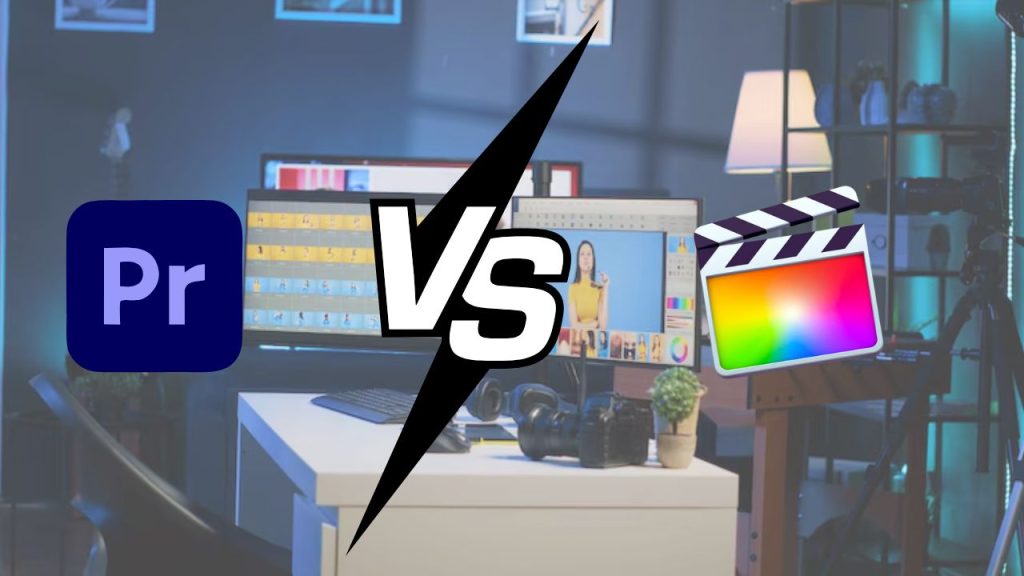In the landscape of video editing, two titans dominate Adobe Premiere Pro Vs Final Cut Pro. They’re both industry-standard software products and are used by professionals and amateur content creators. But in the sense of when it’s time to make a decision, in particular, when newbies or those looking for a switch land on you, will be asked: Adobe Premiere Pro Vs Final Cut Pro what should you do?
This in-depth comparison analyzes the most important differences between the two in order to help you make an educated decision depending on what you require in terms of budget and workflow.
Read More: How Do I Resolve Adobe Premiere Pro Export Errors?
1. Platform for Adobe Premiere Pro Vs Final Cut Pro – Mac Exclusivity vs. Cross-Platform Flexibility
This is usually the no.1 and the most important factor.
- Adobe Premiere Pro: This cross-platform power tool can be used on both Windows and macOS. This makes it surprisingly flexible, particularly if you work with diverse operating systems or people on mixed machines.
- Final Cut Pro: Final Cut Pro is an Apple product for macOS only. Final Cut Pro is off the table if you’re using Windows. But this exclusivity also allows for extensive cooking of how macOS interacts with Apple’s hardware pieces, especially the impressively powerful Apple Silicon (M1/M2/M3) chips, making it blisteringly fast.
Verdict: Adobe Premiere Pro takes the cake for cross-platform versatility with Final Cut Pro ruling the roost as the absolute best Mac-optimized product.
2. User Interface and Usability: Edge vs. Convewong
The way you move about your timeline can make a big difference in how fast you can edit and learn.
- Adobe Premiere Pro: Premiere Pro is built around a traditional timeline, which is represented by track-based editing. Video, audio, and graphics are on separate tracks each, so for example, you could control layering and placement to the nearest frame. Although very powerful and completely customizable, some may find this more intimidating if not a bit more difficult for the absolute beginner.
- Final Cut Pro: The Magnetic Timeline is one of the standout features of Final Cut Pro. La ratio design snaps clips together, eliminates gaps and makes clip management a snap. This is very intuitive and beginner-friendly for sure (especially for those moving up from iMovie), but some power users find it limiting on more complex, multi-layered projects.
Verdict: Final Cut Pro tends to have a faster and more intuitive learning curve for beginners, whereas Premiere Pro offers a bit more freedom and customization for veteran users.
3. Performance and Stability: It’s all about optimization for Adobe Premiere Pro Vs Final Cut Pro
Their performance is very important for smooth video editing, especially for high-resolution videos.
- Adobe Premiere Pro: If you have a decent GPU and CPU Premiere Pro is powerful but its results depend on your computer, especially its GPU and CPU. Occasionally, users report that it might be slow or crash, especially on weaker machines or extremely complicated projects.
- Final Cut Pro: Speaking of performance, Final Cut Pro is at its very best on Apple Silicon Macs. Being optimized specifically for Apple devices, it plays video very smoothly, renders video at a fast speed and exports your video in less time. This performance is a big draw for Mac fans.
Verdict: If you own a Mac, Final Cut Pro often performs and runs more stably than any competitors just because it is optimized for the hardware it runs on.
4. Pricing Model: Tiered Subscription vs. One-Time Purchase
A lot of people look at the cost of such things.
- Adobe Premiere Pro: Premiere Pro is a subscription-based program, usually as part of Adobe Creative Cloud. You can subscribe to just Premiere Pro or the entire Creative Cloud suite, which also includes other crucial apps such as After Effects, Photoshop and Audition. That’s on a monthly or yearly basis, so you’re looking at a continuing expense.
- Final Cut Pro: Final Cut Pro is a one-time buy. You pay for the software once and all future updates are free. This means they can be a better value over time, even though they may cost a little more upfront for some users.
Verdict: Final Cut Pro costs less if you only pay once, but Premiere Pro’s subscription plan unlocks more of Adobe’s ecosystem of creative tools.
5. Ecosystem and Integration: Adobe Creative Cloud versus Apple’s Walled Garden
Your current software package might play a role in your decision.
- Adobe Premiere Pro: As an Adobe Creative Cloud product, Premiere Pro has the integration of other Adobe products such as After Effects (for motion graphics and VFX), Photoshop (for still images), and Audition (for advanced audio editing). This results in a strong integration workflow for full post-production.
- Final Cut Pro: Final Cut Pro tightly integrates with the Apple ecosystem, making it a great option to go with if you find yourself in the macOS, iOS and other Apple apps like Motion for motion graphics and Compressor for advanced encoding. It’s strong in its environment, but not nearly as widely integrated with third-party pro tools as Premiere Pro.
Verdict: Premiere Pro is part of a larger ecosystem and offers a more robust multi-disciplinary creative suite, while Final Cut Pro is deeply integrated within the Apple ecosystem.
6. Industry Standard and Collaboration: It Just Depends
Although both are professional applications, they might be more or less common in different industries.
- Adobe Premiere Pro: Adobe Premiere Pro is a standard application used in videos for broadcast, corporate video and digital media projects. With cross-platform functionality and efficient collaboration features (including Project Team), it’s no wonder that Premiere Pro is a favorite even for newcomers.
- Final Cut Pro: Final Cut Pro’s fast workflow has made it a favorite with indie filmmakers, YouTubers and solo content creators. Although you can use it in a professional environment, you’re less likely to see it used in the same big broadcast environments that Premiere Pro and Avid Media Composer inhabit.
Verdict: Premiere Pro is firmly established in larger industry workplaces with many collaborators, while Final Cut Pro is a good option for individual creators and small production teams especially if they work on a Mac.
Which One Should You Choose Adobe Premiere Pro Vs Final Cut Pro?
In the end, the choice of Adobe Premiere Pro vs Final Cut Pro is one that you should make based on your situation:
Choose Adobe Premiere Pro if:
- You’re working on Windows and macOS or you often work with Windows users.
- Adobe After Effects and Adobe Photoshop integration require a license to After Effects and Photoshop CC as part of the Creative Cloud All apps.
- You’re looking to work in broadcast, film, though Avid has a big footprint here too or big corporate video production, where cross-platform collaboration is normal.
- If you like a traditional timeline you can lay track on precisely.
Choose Final Cut Pro if:
- You are a Mac-only user who has an Apple Silicon Mac and values speed and optimized performance.
- You know and love LaTeX and you want to try something new but find (some of) the existing options too distracting/cluttered, complex or simply not beautiful enough.
- You’re an independent filmmaker, YouTube creative or solo content creator who needs a more efficient workflow and quicker exporting.
- You don’t want to subscribe you want to buy.
Adobe Premiere Pro vs. Final Cut Pro are two video editing powerhouses. The “better” option is the one that fits best with your operating system, budget, workflow style, and career goals. Try free trials (when offered) or watch enough tutorials of both to get a tactile sense before you leap. Happy editing!



